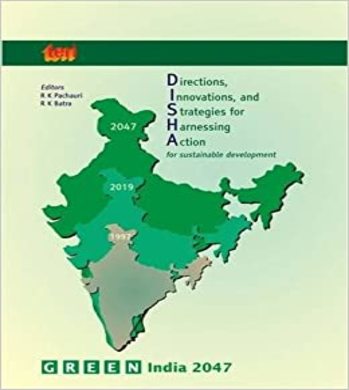Books

Directions, Innovations, and Strategies for Harnessing Action for Sustainable Development
Publication Year: 2001
Author(s): Ravi K Batra, Rajendra K Pachauri (Eds.)
Abstract:
On the Earth Day in 1995, TERI launched its major project titled GREEN (Growth with Resource Enhancement of Environment and Nature) India 2047. A great deal of thinking and consultation preceded its formal launch prompted by the concern that though India has recorded several successes since Independence, the country has perhaps not performed too well in maintaining its wealth of natural resources. The staff of TERI felt that completion of 50 years of Independence is an appropriate time to reflect on the major damage and degradation that has taken place in the environment and natural resources of the country during the period 1947 to 1997. The result was a significant volume of work which clearly demonstrated that something was seriously wrong with India's pattern of development and its inability to protect the very resources on which the society had depended and flourished in the past. The results of this voluminous effort were presented to the then Prime Minister of India, Mr I K Gujral, and major efforts were made to disseminate throughout the country the results obtained and their implications.The publication emanating from this effort, titled 'Looking Back to Think Ahead', has now become a significant piece of literature documenting India's performance in managing its environmental and natural resources over the 50-year period between 1947 and 1997. The document was extremely well received by policy-makers, the corporate sector, scientific community, and by the concerned citizenry. It made front-page news, received wide-ranging coverage in the national press, and formed the basis for a number of editorials. The present volume, titled Directions, Innovations and Strategies for Harnessing Action for Sustainable Development, is the second phase of the GREEN India 2047 project and provides a detailed picture of the impact of development on the environment and natural resources over the next 50 years, outlines specific elements of initiatives or actions to make that development sustainable, and lists the major stakeholders who have to assume responsibility for correcting the aberrations of the past so that the future can become truly sustainable. The study is structured as follows. The first two chapters consist of an introduction and summary.The summary presents highlights of the study and compares two scenarios, the base case (business as usual) and an alternative scenario. The next six chapters focus on challenges, such as India's burgeoning population and opportunities to promote sustainable development though a variety of interventions. The next seven chapters relate to seven sectors of the economy that are most heavily dependent on finite resources or have the maximum impact on the environment. The chapters draw on the mistakes and lessons of the past as documented in the companion volume Looking Back to Think Ahead and list the directions, innovations, and strategies required to achieve the alternative scenario in each of the seven sectors. The final six chapters draw upon the preceding sectoral chapters and highlight the impact on various energy sources and the environment under the base case and the alternative scenario. The present effort can at best be seen as a rough stone out of which a carving has to be produced through the genius and wisdom of the Indian society, various elements of which will be consulted and involved in an effort to enhance the value of this offering.
Publisher/Organisation: Tata Energy Research Institute, 2001
Rights: TERI
URL: https://books.google.co.in/books/about/Directions_Innovations_and_Strategies_fo....

